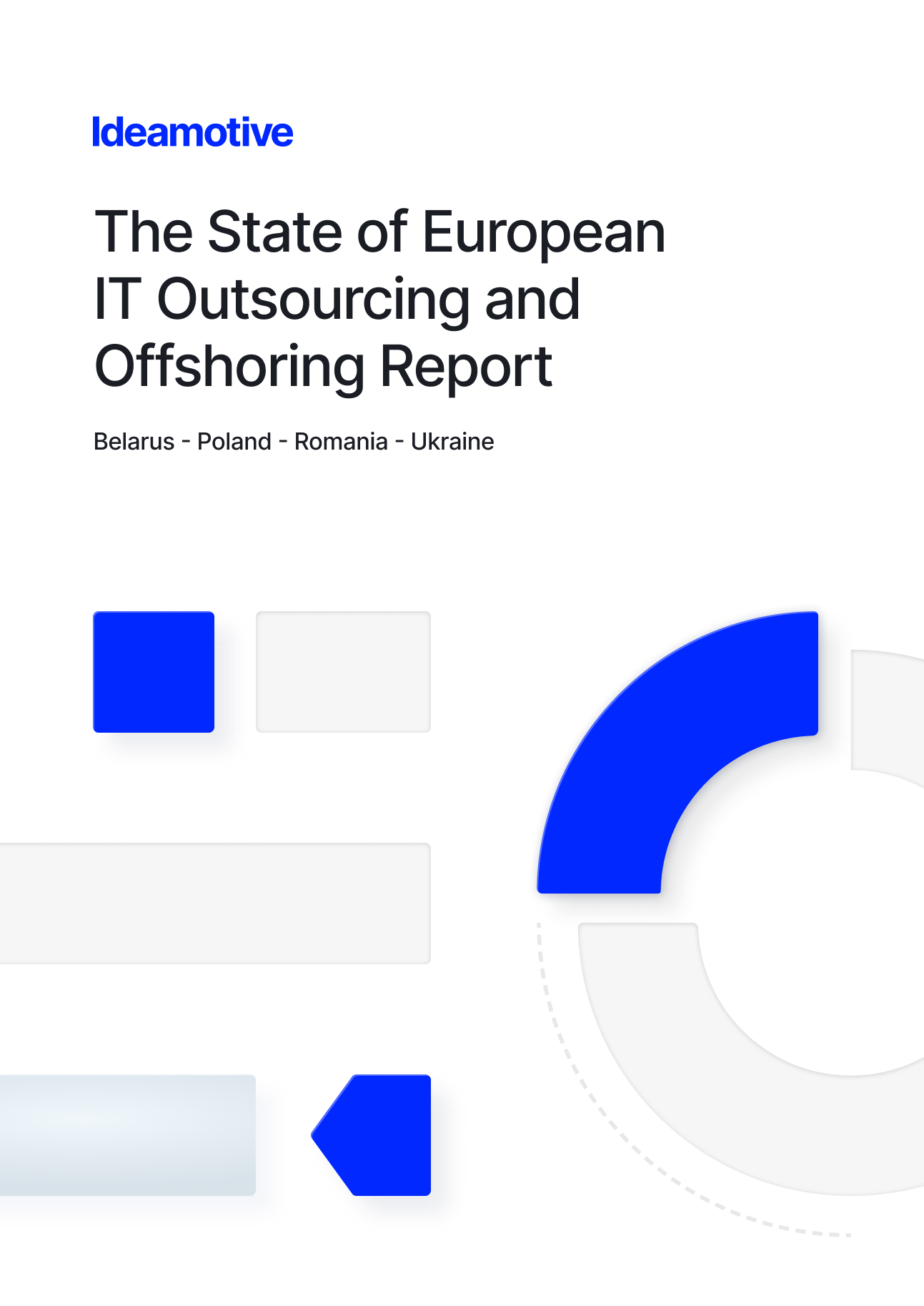The State of Central & East Europe IT Outsourcing and Offshoring Report
Unlock the Potential of Eastern European IT Outsourcing: A Comprehensive Report by Ideamotive.
Our rating on
Hello! Dzień dobry, salut, and Добридень!
We are proud to share with you this in-depth analysis of the state of software development outsourcing and offshoring in the Central & East Europe region.
We hope it will serve all startups, scale-ups, and enterprises that are considering moving their software development abroad.
We focus on individual specifics of described countries when it comes to IT talent outsourcing and paint the picture of the overall business and investing landscape.
Executive Summary
In the face of an impending recession: IT Outsourcing Revisited
As the global economy grapples with the threat of an impending recession in 2023 many organizations moved into economy mode. Now, it's the time to change tactics and shift from 'spending' to 'saving'.
As the looming recession in 2023 adds to the challenges posed by the permanent changes in key business areas, such as work arrangements, customer behaviors, and supply chain ecosystems, companies aiming to prosper must bolster their investment in technology. This will enable them to navigate the crisis unscathed and flourish in the aftermath. However, without IT outsourcing, this may prove to be an insurmountable task, as the pandemic has only worsened the skill shortage in the tech and IT sectors, making it even more difficult for companies to adapt during the uncertain economic times ahead.
The skills gap in IT persists… and widens
"Before the pandemic… there was a skills gap. Post-pandemic, we may be saying there's a skills canyon,"
said Vice-Chair of Prudential Financial, Rob Falzon. And, unfortunately, he couldn't be more right, especially when it comes to ITC professions.
To back up his opinion, let me quote a report by New American Economy, which reveals that computer-related jobs made 69.6% of all foreign labor requests in the USA in 2020. Moreover, the US Bureau of Labor Statistics expects employment in ICT occupations to grow by 13% between 2020 to 2030, faster than in any other profession. These and other sources suggest that the divide between vacancies and the available talent pool will continue to worsen.
Worse still is the detrimental impact of talent shortage on companies' technological progress and—by extension—their competitiveness and profitability. A massive 64% of IT executives see the talent gap as the biggest barrier to adopting emerging technologies, as Gartner has found. Furthermore, 75% cite talent availability as the main adoption risk factor for IT automation adoption.
IT outsourcing is strategic but bound to transform
In light of these findings, I remain confident about the future of IT outsourcing partnerships, as they provide a quick, reliable, and flexible solution to the short staffing problem. Deloitte reports that 65% of successful shared services organizations already include outsourcers in their delivery model, and this trend is likely to continue once the pandemic subsides.
Indeed, the turmoil of the last two years has ushered in the next big wave of IT outsourcing contracts, creating new opportunities due to the surge in hybrid and remote work, the e-commerce boom, and the growth of automated services. Consequently, the more enterprises will want to invest in the global IT sector—now estimated at over $4 trillion—the more they will need to rely on external support to tap on the opportunities brought by modern technologies.
At the same time, one shouldn’t expect that IT outsourcing engagements will return to the pre-pandemic normal unchanged. As the rules of the game have changed for good, it’s time to revisit how businesses will interact with IT and software development services suppliers.
Time for a new chapter
So what will be the new rules for the IT outsourcing sector? Unfortunately, there's no crystal ball to tell this for sure. However, based on our research and conversations with clients, partners, and industry leaders, we anticipate the following strategic trends to define the engagements between IT services providers and suppliers in 2023 and beyond:
-
Relocating outsourced services closer to home. When supply chains ground to a halt when the pandemic started, many companies began questioning the resilience of their global partnerships. The pandemic volatility has directed their focus to nearshoring to afford greater control over their contracts while filling open IT positions. While this trend had begun before COVID, it's likely to intensify following the global crisis. Cost reduction used to be the holy grail of outsourcing arrangements; now, we expect enterprises to focus predominantly on the flexibility and reliability of their outsourcing partners.
-
Shift to obtaining high-skill, high-value talent. In 2023, companies are also likely to seek more sophisticated outsourcing, where they will be looking for specialized, expert skills. "Larger firms that have full-time staff devoted to IT operations are keener to bring in technology consultants and advisors for strategic guidance and large project execution," said Fred Chagnon, a principal research director with Info-Tech Research Group. And I couldn’t agree more. As low-skilled, manual work becomes increasingly automated, IT outsourcing organizations will need to upskill their staff to meet the customers' demand for specialization.
-
A surge in RPA, AI, and cloud projects. Finally, IT outsourcing providers will need to address the evolving enterprise needs regarding technologies. 56% of businesses plan AI adoption, mainly within service operations optimization, product enhancements, and contact center automation. At least 48% of firms will outsource AI and automation services to established partners to transform traditional corporate operations into intelligent ones. Global Shared Services organizations will be primarily looking to increase traction in RPA systems (33%), reporting solutions (30%), and predictive, customer, and regulatory analytics (44%). Finally, cloud competencies will remain in demand, especially considering the predicted massive uptake of cloud-native platforms (Gartner predicts that by 2025, they will serve as the foundation for over 95% of new digital initiatives).
Where to start with IT outsourcing ?
The last two years wreaked havoc on businesses worldwide, but companies are slowly recovering from the disruptions. Since IT outsourcing will be instrumental in the process, we've assembled this report to help them take advantage of its benefits to grow and thrive in the new reality.
This updated State of Central & East Europe IT Outsourcing and Offshoring report presents a comprehensive analysis of the leading software development outsourcing and offshoring centers in Europe. We zoom in on Belarus, Poland, Romania, and Ukraine specifically, examining their strengths and weaknesses as outsourcing destinations and providing detailed insights into their dynamic investment landscapes.
I hope you enjoy reading!

Robert Krajewski
CEO of Ideamotive

The State of Central & East Europe IT Outsourcing and Offshoring Report
Belarus - Poland - Romania - Ukraine
What will you find inside the report?
How the recession is changing the global IT outsourcing market?
What are the specifics of IT outsourcing in Central & East Europe countries?
How companies can benefit from working with Central & East Europe tech talent?
How do the tech and investing landscape in Central & East Europe look like in 2023?
What are the market and industry predictions for the future to come?
One report. Four countries.
We have selected four Central & East European countries with the highest IT outsourcing potential and the biggest pool of tech talent: Poland, Ukraine, Belarus, and Romania.
-
IT Outsourcing In Belarus
Considering that 90% of its IT market is external or outsourced, Belarus has a strong reputation as a reliable IT outsourcing destination. Belarus's robust IT sector is believed to be growing four to five times faster than in other countries. Government-led initiatives such as public subsidies, tax incentives, and free economic zones for IT & tech companies encourage establishing private sector enterprises
READ MORE -
IT Outsourcing In Poland
Poland's central location on the European map makes it a strategic gateway between East and West, always within easy reach. It has the largest and most versatile pool of developers and the highest rank when it comes to the easiness of doing business. Its broad ecosystem of innovative startups, entrepreneurs, and enterprises, combined with robust digital infrastructure, encouraged numerous global corporations and scaleups to move their operations there.
READ MORE -
IT Outsourcing In Romania
The least familiar of the featured countries, Romania is emerging as a hidden gem for technology outsourcing and offshoring. Several key factors contribute to this: high quality of education, strong communication skills, and blossoming innovation ecosystems. These aspects stem from a long-term, concerted Romanian authorities' effort to increase the country's competitiveness, improve school instruction quality, and adopt higher study programs that support tech-oriented education.
READ MORE -
IT Outsourcing In Ukraine
Ukraine is systematically gaining weight as a go-to Central & East Europe IT outsourcing destination, mainly due to two dominant factors – a vast tech talent pool combined with low labor costs. The largest by size and population of the four discussed countries, the country has a vibrant tech community actively engaged in regular meetups, seminars, and conferences The huge pool of IT professionals is regularly expanding as, each year, about 20,000 tech students graduate from Ukrainian universities.
READ MORE
.png?width=493&height=328&name=Grafika%20www%201%20-%20493%20x%20328%20(2).png)
.png?width=378&height=313&name=Grafika%20www%202%20-%20312%20x%20377%20(2).png)
Key Findings From The Report →
.png)
The IT Service and Software R&D market in the Central & East Europe region grows x4-5 faster than the global average. As of the end of 2022, there were 44 unicorns and nearly 1/3 of them are located in Poland (privately held companies with a valuation exceeding $1 billion).
Strong technical expertise, good command of English, cultural proximity, and an innovation mindset are the most significant pull factors for foreign investors.
The projected revenue in global IT outsourcing reached nearly $400 billion in 2022. Within the next five years, it's expected to show a CAGR of 8.07%.
The region’s sizable STEM and ICT talent base is growing in skillset and number. There are over 1 million tech experts in the Central & East Europe market!
Quotes from the report:
My experience of doing business and investing in the Central & East Europe region has been hugely positive. A major draw to the region is the language capabilities that workers there offer. Industry’s close connection with many third-level institutions also makes talent acquisition a lot less of a challenge than in other regions.
Dan Kiely
Founder & CEO at Voxpro
Unlike other outsourcing destinations, Eastern Europe is associated with top quality services backed by highly experienced technical people at a reasonable cost.
Fatmir Hyseni
CMO at Kosbit
Today, global sourcing has achieved a great range of outsourcing services from Eastern European countries, especially in or based on IT, with reasonable pricing, great expertise, cultural proximity, etc.
Sergei Makendoski
Regional Director at Forrester Research
Get your free copy of the report now
The State of Central & East Europe IT Outsourcing and Offshoring
Belarus • Poland • Romania • Ukraine
We are Ideamotive.
A tech talent marketplace providing on-demand IT experts matched with client's technology, industry, and company culture.
Want to ask about the content of the report?
Or just talk about outstanding hiring?
Rated 4.8 / 5.0 by clients from various industries and locations.

